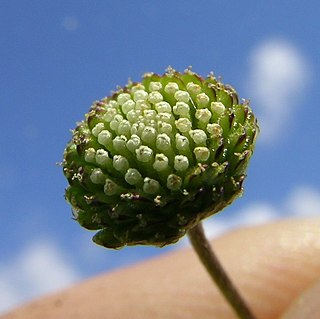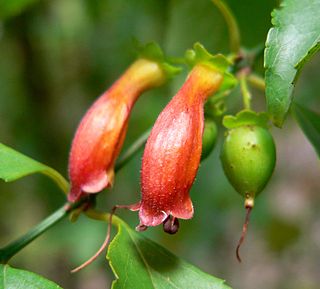
Lycopodium clavatum is the most widespread species in the genus Lycopodium in the clubmoss family.

Dimorphotheca sinuata, the glandular Cape marigold, Namaqualand daisy, or orange Namaqualand daisy; syn. Dimorphotheca aurantiaca hort.) is a species of plant native to southern Africa. It is also widely cultivated as an ornamental and naturalized in parts of the United States, primarily California and Arizona.

Cotula australis is a species of plant in the daisy family known by the common names bachelor's buttons, annual buttonweed, southern waterbuttons and Australian waterbuttons. This small plant is native to Australia and New Zealand, but it is known in other areas of the world as a common weed.

Burchellia is a monotypic genus of flowering plants in the family Rubiaceae. The genus contains only one species, viz. Burchellia bubalina, which is endemic to southern Africa: the Cape Provinces, KwaZulu-Natal and the Northern Provinces in South Africa, and Eswatini. It is commonly known as wild pomegranate (English) or wildegranaat (Afrikaans).
Alatoseta is a genus of flowering plants in the family Asteraceae described as a genus in 1931.
Hydroidea is a genus of flowering plants in the family Asteraceae.
Oedera montana is a species of South African flowering plants in the family Asteraceae. It is endemic to the Cape Provinces. It was once assigned to the genus Oreoleysera, and was the only species recognized in that genus.
Petalacte is a genus of flowering plants in the family Asteraceae.
Planea is a genus of flowering plants in the pussy's-toes tribe within the sunflower family. The only known species is Planea schlechteri, a rare and threatened species known from only a single population in Western Cape Province in South Africa.
Oligothrix is a genus of flowering plants in the groundsel tribe within the sunflower family.
Heterorhachis is a genus of South African flowering plants in the family Asteraceae.
Myxopappus is a genus of southern African flowering plants in the chamomile tribe within the daisy family. It is native to Namibia and the Cape Provinces of South Africa.

Oncosiphon is a small genus of flowering plants in the daisy family (Asteraceae). All known species are native to southern Africa.

Halleria is a genus of flowering plants in the family Stilbaceae described as a genus by Linnaeus in 1753.
Fanninia is a species of plants in the family Apocynaceae first described as a genus in 1868. It contains only one known species, Fanninia caloglossa, native to South Africa

Riocreuxia is a plant genus in the family Apocynaceae, and named in honour of the botanical illustrator Alfred Riocreux (1820-1912). It was first described as a genus in 1844 and is native to Africa.
Periglossum is a genus of flowering plants in the family Apocynaceae, first described as a genus in 1844. It is native to southern Africa.
- Periglossum angustifoliumDC. - South Africa
- Periglossum kassnerianumSchltr. - South Africa
- Periglossum mackeniiHarv. - South Africa
- Periglossum macrumDecne. - South Africa
- Periglossum mossambicenseSchltr. - Mozambique
Capelio is a genus of flowering plant in the Asteraceae first described as a genus in 1836 with the name Alciope. It was renamed Capelio in 2002 after it was determined that the name Alciope was not legitimately published according to international nomenclatural rules. Capelio is a taxonomic anagram derived from the former name Alciope.

Ixianthes is a genus of flowering plants in the family Stilbaceae described as a genus in 1836.
Gymnopentzia is a genus of African plants in the chamomile tribe within the sunflower family.







